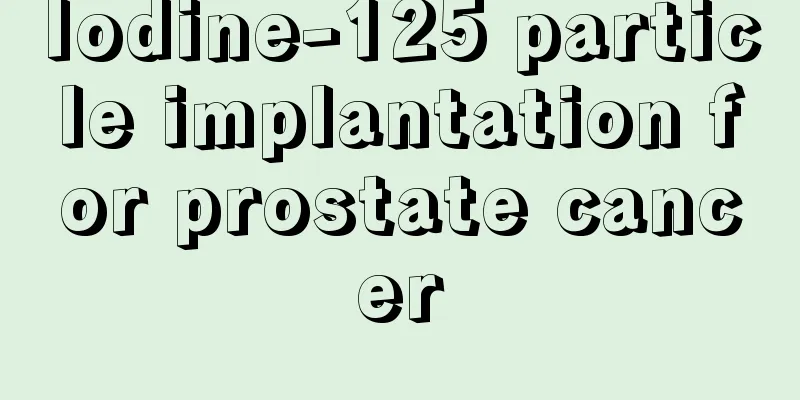Iodine-125 particle implantation for prostate cancer

|
Prostate cancer is the most common malignant tumor of the male reproductive system. Its incidence increases with age. There are obvious regional differences in its incidence, with higher incidence in Europe and America. According to reports, in 2002, the number of new cases of prostate cancer in the United States reached 189,000 per year, and about 30,200 people died of prostate cancer. The incidence in my country is also on the rise. The incidence of latent prostate cancer in men over 70 years old is 25%, of which 9.51‰ can develop into clinical prostate cancer. It is reported that it is the second leading cause of cancer death in men, second only to lung cancer. The incidence rate in my country was low before, but it has increased in recent years due to the aging of the population. At the same time, the continuous improvement of the diagnostic methods for prostate cancer, such as radioimmunoassay of acid phosphatase, determination of lactate dehydrogenase in prostate fluid, transrectal ultrasound imaging, CT examination and improvement of prostate puncture needles, has enabled early diagnosis of prostate cancer, which has also increased the incidence rate of prostate cancer. At present, radical prostatectomy and iodine-125 seed implantation are mostly used to achieve a radical cure. Iodine-125 seed implantation for prostate cancer is to implant iodine-125 seeds into the prostate through the guidance device of the treatment planning system under B-ultrasound, so as to achieve the purpose of treating tumors by internal irradiation therapy, while ensuring that the radiation dose delivered to the surrounding normal structures is minimized. In the United States, only 4.2% of patients with localized prostate cancer received iodine-125 seed implantation in 1996. Due to the advantages of iodine-125 seed implantation, which is effective, minimally invasive and has few complications, 60% of prostate cancer patients now receive iodine-125 seed implantation. Principles of iodine-125 seed implantation therapy Iodine-125 particle implantation therapy damages the double-stranded DNA through the direct effect of radiation or the indirect effect of the free radicals produced. When tumor cells divide, they cannot divide and die because the integrity of their DNA is damaged; tumor cells that do not divide can survive for a longer time. Generally, cells in the M and G2 phases are more sensitive to radiation, while cells in the S phase are not sensitive. Advantages of iodine 125 seed implantation ⑴ Give a higher dose to the prostate than external beam radiation therapy; ⑵ The dose to the bladder and rectum is lower than that given by external beam radiotherapy; ⑶ Continuous low-dose irradiation therapy can be given, which is more effective than external irradiation therapy and is suitable for treating long-term, slowly progressive prostate cancer; (4) Iodine 125 can penetrate into local tissues, with good therapeutic effect and minimal damage. Efficacy, complications and follow-up A large number of studies have shown that there is no significant difference in the efficacy of iodine-125 seed implantation for prostate cancer, radical surgery, and external radiotherapy. The efficacy of iodine-125 seed implantation for prostate cancer is related to clinical stage, Gleason score, and blood pSA level. Complications of iodine-125 particle implantation therapy include short-term complications and long-term complications. Short-term complications (within 1 year) are related to puncture trauma and acute radiation damage. Most patients have urinary tract irritation symptoms such as frequent urination, urgency and pain after surgery, and some patients show difficulty urinating and increased nocturia. Most studies believe that after 1 year, 90% of patients' urinary tract symptoms can return to normal. The incidence of acute urinary retention is 1%-34%, which is more common in patients with higher IpSS scores and longer prostate length. Short-term rectal complications are rectal irritation symptoms such as increased bowel movements and tenesmus, which are mostly self-limiting and can generally be treated symptomatically. Long-term complications (occurring after 1 year) are mostly chronic urinary retention, which is mainly related to scarring caused by radiation damage to the bladder neck and urethra. The incidence of urinary incontinence is 1%-24%, and the incidence is as high as 20%-85% in patients with a history of TURp surgery. About 12% of patients present with urethral stenosis, which may be related to excessive radiation doses in the bulbar urethra and can be resolved by regular urethral dilation. Proctitis occurs within 3 years after implantation. It is often manifested as mild blood in the stool, which is often self-limited, but in severe cases, rectal ulcers and even prostate rectal fistulas may occur. As a treatment method with proven efficacy, minimal trauma and few complications, brachytherapy will have broad development prospects in my country. |
<<: Does an increase in PSA necessarily mean prostate cancer?
>>: Symptoms of prostate cancer brain metastasis
Recommend
Spinal cord injury classification method
The levels of spinal cord injury are divided into...
How is lactic acid produced in the human body?
I believe many people have had this experience, t...
How long does lymphoma last?
Many people who have cancer think that treatment ...
Which hospital is good for treating ovarian cancer
Which hospital is good for treating ovarian cance...
Prejudice causes bone cancer to be misdiagnosed as pneumonia
Mr. Lin, who is in his 60s, has usually been in g...
What are the dangers of digging belly buttons?
If there is dirt in the belly button, many people...
How to remove tea stains from teacups
We all know that no matter what kind of thermos c...
What to do if your frosted shoes get dirty?
Nowadays, many people like to wear matte shoes. W...
I suspect I have depression
Speaking of depression, people should be familiar...
What is the reason for the black teeth
In daily life, we often encounter various dental ...
Do you sleep at noon during the college entrance examination?
Most candidates are quite nervous before the coll...
Does Acacia vine leaf tea have the effect of removing toxins?
Nowadays, many people prefer to eat some original...
How long does it take to digest a meal?
The human body needs to take in a variety of nutr...
What are the benefits of deep sea fish oil for women
Women are under a lot of pressure in their curren...
Dietary remedies for different types of prostate cancer
Traditional Chinese medicine divides prostate can...









